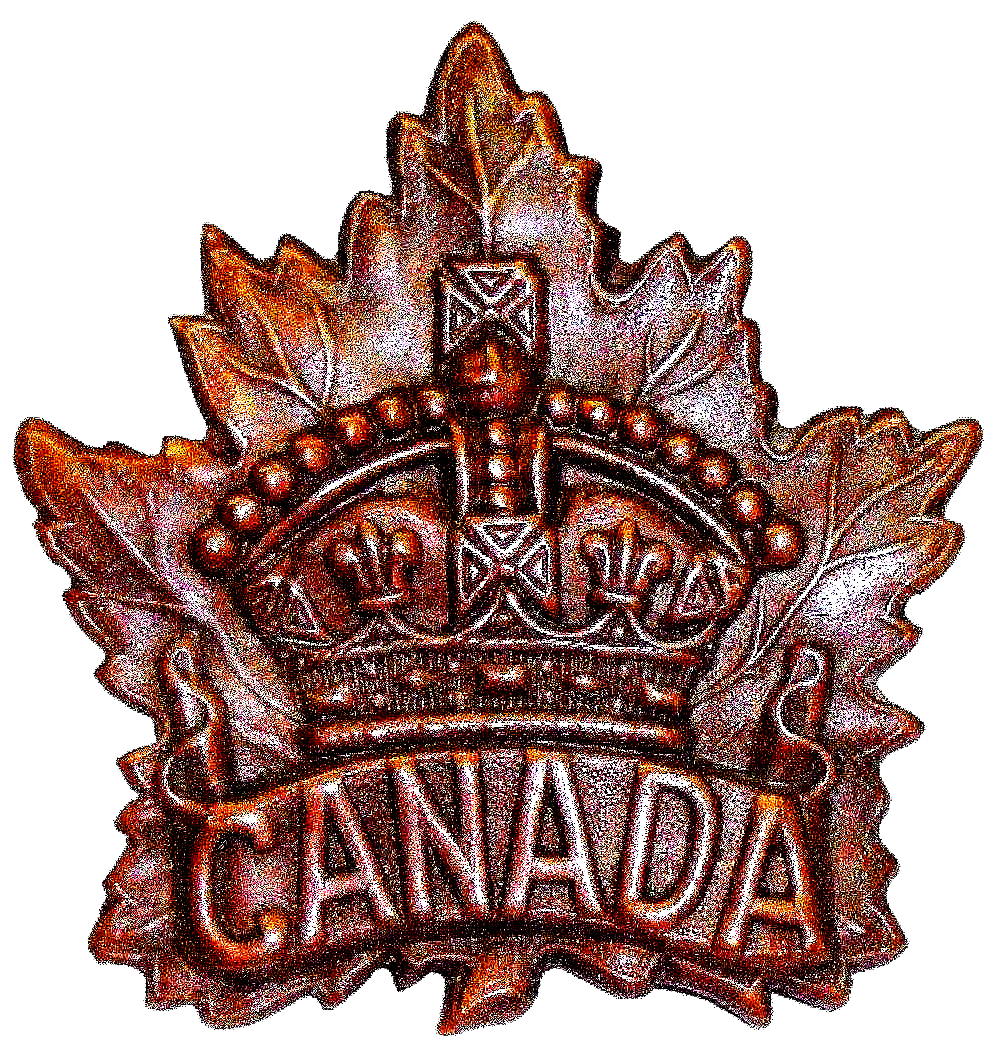
OPCMH
ORGANIZATION
for
PRESERVATION
of
CANADIAN
MILITARY
HERITAGE |

OPCMH
Visitor No.
1455437
since
2015-03-21
| |
HISTORY OF WORK POINT BARRACKS
by Jack Bates
PART 3 — 1894 to 1906
1903
The Royal Engineer’s Journal
January 1, 1903
DESCRIPTIVE ACCOUNTS OF STATIONS ABROAD
ESQUIMALT, BRITISH COLUMBIA
Click here for PDF document
COLONIST
March 8, 1903 (12)
SIGNAL HILL AND ITS GUNS
Slowly but surely the complete system of coast defence planned by the War Department for the protection of the Imperial supply depot at Esquimalt is being carried out. A few days ago ground was broken on the work of fortifying Signal Hill - the high rock overlooking the harbor, and just above the little village church. One of the views reproduced with this article shows Signal Hill and the War Department supply stores and Artillery jetty as seen from Foster’s Pier. All these buildings are most massively constructed, and together with the pier, are good examples of the handiwork of men “of the rank and pay of a sapper.”
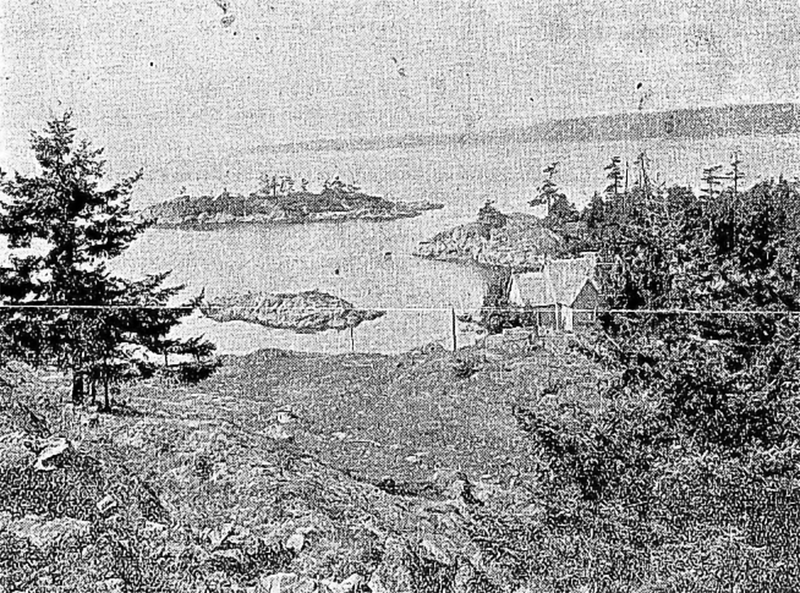 |
| View from the summit of Signal Hill looking towards Race Rocks |
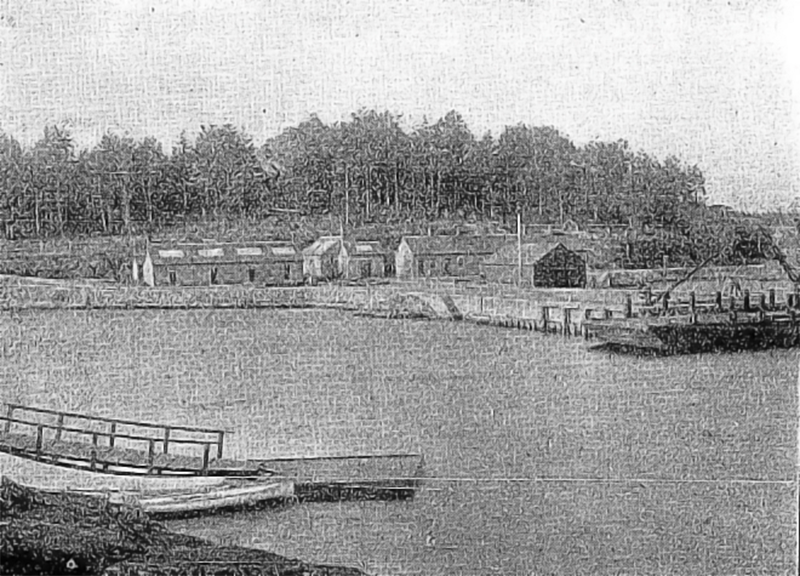 |
Signal Hill from Esquimalt Harbour, showing Artillery Stores.
The guns will be mounted on the pinnacle of the rock near centre of view. |
The stores shown in this picture constitute the station depot of the War Department as distinguished from the other branch of the Imperial service as represented in the naval yard and stores further along towards the mouth of the harbor. The latter is under the direct control of the Lord’s Commissioners of the Admiralty, while the former appertains to that beta noir of the average unitary critic at home or abroad – the department presided over by the Hon. Mr. Brodrick.
The fortifying of Signal Hill is part of the local scheme of defence, constituting what may be termed Esquimalt Fortress, and includes Forts Macaulay, Rodd Hill, Black Rock and the fort under review. At the three first named 6.3 B.L. guns have been mounted, but it has been decided that a much more formidable weapon – the 9.2 B.L. gun – shall be mounted on Signal Hill.
In order to judge of the relative sizes of the 6.3 and 9.2 guns, the accompanying picture of the former and a 7 inch gun may be studied. The great difference in size between these two guns which are less than one inch difference in the bore will be seen at a glance, and when it is borne in mind that the 9.2 weapon is nearly 3 inches greater in diameter than the smaller of the two named the reader can form a very fair notion of the enormous size of the guns to be mounted on Signal Hill when compared to those now to be seen at Macaulay and Rodd Hill.
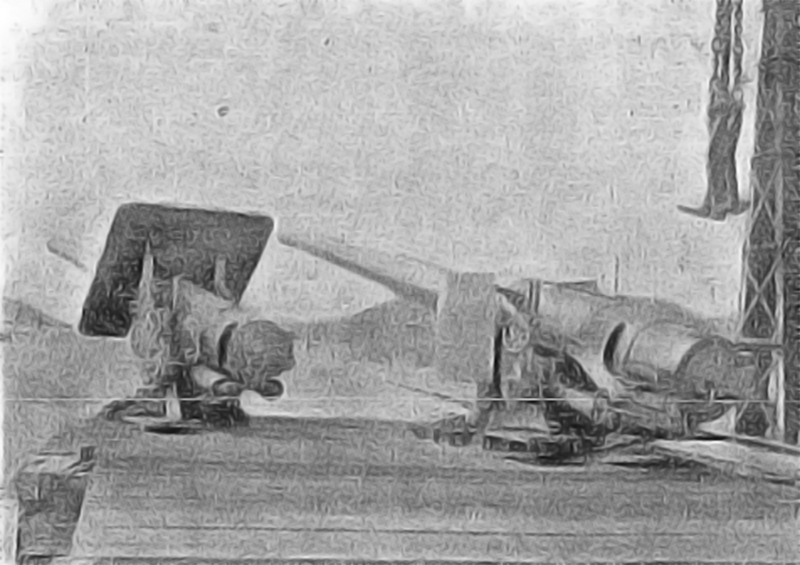 |
6.3 and 7. BL guns, showing the relative size.
The smaller gun is as those mounted at Fort Macaulay |
A photograph of the 9.2 B.L. gun is also given, and the great length of the barrel will be noted. This gun is one of the most recent pieces of service ordnance and what is termed “a wire wound” gun, weighing 19 tons. The carriage on which it is shown in the picture is termed “an expanding mounting” and is intended for high angle fire. The 9.2 B.L. gun is one of great power and penetration. In the series of trials in England, during which the photograph was taken, the projectiles fired were Palliser (solid) shot, weighing 382 pounds, with a charge of 270 pounds of powder. The gun was fired at various angles of elevation, the maximum range obtained being not less than 12 miles, the elevation in that case being 40 degrees, and it was calculated that the extreme height attained by the projectile was about 16,000 feet, or three miles. This would bring Race Rocks light well within range of the guns on Signal Hill. The time occupied by the flight of the shot was slightly over one minute. The result is one of the achievements of modern gunnery. Great range and penetration are largely due to the introduction of the wire-winding system, which gives high resistance in the guns, and thus enables heavier charges to be used. The coast 9.2 inch gun weighs 27 tons and has a muzzle energy of 16,200 foot-pounds.
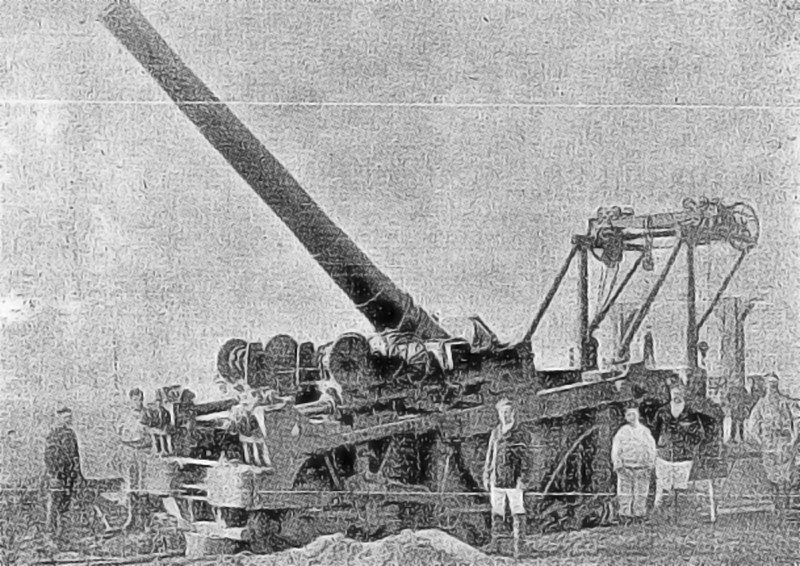 |
| 9.2 BL gun, two of which are to be mounted at Signal Hill. These guns are practically quick fire, as with a trained crew, two shots per minute have been had with this weapon. The shot weighs 380 pounds. |
The 9.2 guns are not mounted in pits, as is the case at the other forts armed with the 6.2 inch guns. The former are mounted on barbettes, having shields for the gun and crew, the whole being worked on a turntable. Solid platforms of brick and cement will be erected on the apex of Signal Hill and the two monsters will be mounted on these. The guns and mountings are not concealed as is the case with lighter guns. Over the tops of the guns, as a protection from the weather, light corrugated iron hoods are erected.
The buildings now in in course of erection, near the car track at Signal Hill, are intended as officer’s and men’s quarters, while a little further up the rock is a second building which will doubtless be a storeroom. The excavations for the magazine are being made immediately in the rear of the hill.
Parts of the new armament have already arrived, and the guns themselves will be on hand by the time the platforms will have to be erected. The fact that no “pits” have to be dug to accommodate these large guns renders the cost of their mountings much less than in the case when disappearing carriages similar to those at Fort Macaulay are used. Of course, the extreme length of the 9.2 gun precludes the latter style of mounting in any event.
COLONIST
March 14, 1903 (7)
ESQUIMALT IS TO REMAIN
DEPARTMENT DECIDES NOT TO EXPROPRIATE LAND OCCUPIED BY TOWN
FIRING OF BIG GUNS ON SIGNAL HILL WILL DAMAGE PROPERTY
Rumors have been rife for many years that the neck of land commencing at the Eastern boundary of the Canteen grounds and including all the intervening territory up to the Western limits of the Dockyard, would be expropriated for military purposes, under the Imperial scheme of defence of the naval arsenal and station at Esquimalt.
At various times officers have expressed the opinion that the acquisition of this land would be inevitable, it being necessary to guard the approaches to the heavy guns on Signal Hill. As the scheme of defence embraces an increase in the garrison and the armament, it was considered that at cordon would be established around the small peninsula on which Esquimalt is situated, and extending up to the Eastern boundary of the canteen grounds. Color was lent to this view of the subject by explicit announcements in the ministerial press that the expropriation measures above outlined would be adopted.
These rumors, apparently well founded, had a marked tendency to discourage any buildings being constructed by owners of property within the Town of Esquimalt. The intention of the War Department to put 9.2 guns on Signal Hill has practically rendered the property valueless from a residential aspect. These property holders had every reason to expect that expropriation proceedings would be instituted without delay. It has been no secret that the land has been surveyed under instructions from the Dominion government, and also that an appraiser has been appointed to fix the land values as soon as the survey shall have been completed. Recently, Col. L.T. Pinault, Deputy Minister of Militia and Defence, visited Esquimalt, and looked carefully over the ground with a view of ascertaining the amount of land which would be necessary to immediately acquire. As a result of his inspection, he arrived at the conclusion that, in view of the limited appropriation at the disposal of the government, it was not imperative to acquire the land West of ST. Paul’s Church. However, the matter was not definitely determined until he should report to the Minister of Militia. In the mean-time negotiations have been carried on with various property holders with the object of ascertaining what terms for sale would be accepted by them.
These negotiations have come to an abrupt termination by the receipt of a letter from Lt. Col. Pinault, that it has been decided no to purchase the lands under consideration. The property holders, as a consequence, are thus obliged to have their holdings depreciated by the firing of monster guns from Signal Hill with all the attendant danger of premature explosions, rendering the property practically uninhabitable. Of course the shells will be fired at a lofty altitude and the guns will be trained seawards, but this will not minimize the discomforts and dangers due to heavy detonations and premature explosions. Under these circumstances it is believed that the property owners suffering from the measures of defence now being established will seek redress by having recourse to the Exchequer Court in an effort to recover adequate compensation for the damage sustained by their realty in Esquimalt.
Daily Colonist
April 15, 1903
Military School — The school for the soldier’s children at the Barracks, opened yesterday, and all those that have been attending the Victoria West school will after this attend the military school.
May 5, 1903
Signal Hill. — Work is progressing on the fortifications at this point. The roadway around the northern face of the hill is approaching completion, and the sites for the big guns on the summit of the rock have been marked out in white paint. The new buildings at the foot of the hill are well advanced, and a week or so will see them completed.
Work Point Barracks. — Capt. Probyn arrived from England on Saturday, and will join No. 83 Company of Royal Garrison Artillery. Major Gurdon left for England on Saturday on urgent private affairs. Every Tuesday evening from now on the Royal Artillery will man the forts in the Esquimalt Harbor, viz., Duntz Head, Belmont and Black Rock. The Royal Engineers will work the searchlights from Signal Hill, and a steam pinnace will endeavor to enter the harbor, and when she is discovered by the searchlights, will be bombarded with blank ammunition from the quick fire batteries stationed in the above named forts.
June 20, 1903
ACCIDENT AT FORT MACAULAY
Sergeant Margison Struck In Chest By Tube From 6 Inch Gun
Sergt. Margison was the victim of a serious and painful accident yesterday morning at Fort Macaulay. The gun layer was testing the tube in the bent of one of the 6 inch guns preparatory to firing, when the tube flew out and struck Margison in the right breast. The tube penetrated about three inches and glanced off at the collar bone. The surgeon from the barracks was hastily summoned and the wound was dressed in the guardroom. Margison was afterwards sent to the hospital. The tubes are made of brass and consequently it penetrated like a bullet.
The regiment did not commence its annual firing till nearly 8 o’clock a.m., and was not concluded until 9:30 a.m.
The reveille was sounded at 4:30 a.m., and the men were paraded at the fort at 5 a.m. The results of the shooting with the big guns was very satisfactory as far as could be judged from the forts. Nothing definite as to the score will be known for about a week.
The officer’s mess held a mock court-martial last night at camp, on one of the juniors. The charge was that of shaving in the officer’s mess with a safety razor, and hot water. Co. hall acted as president and Capts. Langley and Currie as judges, and Lieut. McTavish acted as judge.
The sham fight at Camp Macaulay was again postponed last night on account of the lateness of the hour which the tug-of-war heats were concluded. The preliminary heats for the Col. Gregory Cup were very exciting, and were well contested. No. 3 company and the band were the first to take the field. After a good hard struggle, the bandsmen were adjudged the winners of the heat. Nos. 5 and 2 came next, and the honors went to the former company. The winning team won their heat with great ease. Nos. 6 and 1 were on the list to pull next, but No. 6 had not their complete team, it was postponed until tonight.
The officers have been busily engaged, the last day or two interviewing the employers of labor with a view to getting off every member of the regiment for Monday next, and have met with most encouraging success in the large majority of instances, one officer making the remark that the only refusal he had so far heard of was, strange to say, from the Imperial government representative at the Dockyard, who, presumably, does not encourage military training for the Canadian forces.
Annual infantry Inspection of the Regiment Takes Place Today
This afternoon is the infantry inspection of the Fifth regiment at Macaulay Point, after which the field batteries will go through their annual firing practice at the same place.
Club Servant Is Under Arrest
Alexander Gordon, Bartender of the Union Club is in the Toils
Arrested Yesterday For Stealing a Pocketbook Four Years Ago
Alexander N.B. Gordon, who has been engaged as bartender at the Union Club for some time past, was arrested yesterday afternoon by Detectives Palmer and Perdue, on a warrant issued at the instance of members of the club, charging him with the theft of a pocket book, with $75, a draft and a return ticket inside, four years ago on March 30, to be exact. This pocket book, of leather with silver mountings, was lost four years ago by Mr. N.B. Graham, a visitor from England, who on the day the book and money was missed went with Sir Richard Musgrave, his friend, to the United Service Golf links at Macaulay Point. When there, he missed the book and money, and returning to the city he inserted an advertisement in the Colonist of March, 1899, offering to pay a reward of $25 for the recovery of the missing purse and contents, which, the advertisement stated, had been lost between the Union Club and the golf links at Macaulay Point. It seems that it had been lost at the club, and there picked up by Gordon, who had appropriated it. Nothing was heard by the owner, however, and he sometime afterwards returned to England.
After the lapse of four years though, the theft has just been discovered during the investigation of other thefts which have occurred at the club — and many of which are alleged to have been committed by Gordon. It seems that coats have been missed, cigars, small sums of money, club tickets, and other things. Many were the articles missed, and an investigation was commenced, which resulted in Gordon being taken to the city lockup with a charge of stealing registered against him. It was during the investigations that it came to light that Gordon had taken the missing purse in 1899 — and this purse, minus the contents, has been recovered. It seems that Gordon himself told of having taken the purse, he having spoken to friends of the theft, and they repeated the conversation at this late date.
Some time ago, several articles were missed at the club, and suspicion pointed to Gordon. He was suspended from the club service on that occasion, but was afterwards given his post as bartender again. Within the past few months numbers of club tickets have been missed, coats have been taken and other things gone astray — and suspicion passed to Gordon.
A search of his premises resulted in the discovery of some things alleged to have been taken from the club, and among other things an unopened box of Ecuador cigars was found on a shelf, alongside a long box of assorted cigars. The stewards of the club reported having missed the box of Ecuador cigars. The irregularity of the recent secretary is said to have aided the populations of the accused man, for access was given he and other club servants to tickets etc. Then again, members allege that Gordon has been an artist in working short change on them — and there are other stories, but these will probably come out in the trial of the case in the Police Court.
Gordon, who will be brought up in the Police Court this morning, is a former soldier. He is a man of about 38 or 40 years of age, and came to this city with "C" Battery, from which he has secured his discharge. He is said to have been an ideal servant. Gordon was married three years ago, and has just completed the construction of a new house, which was erected for him at a cost of $1,600, and both this and the lot on which it is built, and which cost $500, have been paid for.
COLONIST
August 23, 1903 (9)
E.G. CARY’S BLACKSMITH SHOP – CHEMAINUS, B.C.
A good business and a good mechanic running it. Mr. Cary has decided to retire and is desirous of either selling or leasing his property and the good will. Here is a good chance for some enterprising young man. An established business to be had for a very moderate figure.
The proprietor has an interesting and enviable record. He was late Brigade Farrier Sergeant-Major of the R.H.A., also of the 2nd C.M.R., and served in the South African campaign, being present at the last battle with the Boers at Hart’s River. He has been through the following campaigns from 1872 to present time: Abyssinians, Ashantee, Afghanistan, Zulu, March from Candahar to Cabul with F.M. Lord Roberts, siege of Alexandria, battles of Tel-el Keber, El-teb and Tammie, Soudan campaign, with General Lord Kitchener, being present at the battles of Suakim, Handuff, Alhin, and Berber. For this campaign Sergeant-Major Cary received the Egyptian medal and Khedive Star. He also served as already stated, in the lately closed Transvaal war with Colonel Cookson and Colonel Evans, C.M.R. He has the distinction of holding more active service bars, stars and medals than any other man in Canada. Viz: eighteen bars, two stars and six medals.
The ROSSLAND MINER
September 22, 1903
The freighter Ning Chow brings two 9.2 guns for Signal Hill in Esquimalt. Mounts have already been placed.
COLONIST
September 27, 1903
There were landed from the steamer Kingchow at Esquimalt the other day two 9.2 in. B.L. guns for the armament of the new fort on Signal Hill. These huge monsters will in due course be mounted, on the very summit of the rock and with their fire will command the whole sea front as far as Race Rocks and beyond. Last March the Colonist published an article dealing with the subject of Signal Hill and the following extract and above illustration both taken from that issue will prove of interest at the present time.
The fortifying of Signal Hill is part of the local scheme of defence, constituting what may be termed Esquimalt Fortress, and includes Fort Macaulay, Rodd Hill, Black Rock and the fort under review. At the three first named, 6.3 B.L. guns have been mounted, but it has been decided that a much more formidable weapon, the 9.2 B.L. gun shall be mounted on Signal Hill.
A photograph of the 9.2 B.L. gun is also given, and the great length of the barrel will be noted. This gun is one of the most recent pieces of service ordnance and what is termed “a wire wound” gun, weighing 19 tons. The carriage is on which it is shown in the picture is termed “an expanding mounting” and is intended for high single fire.
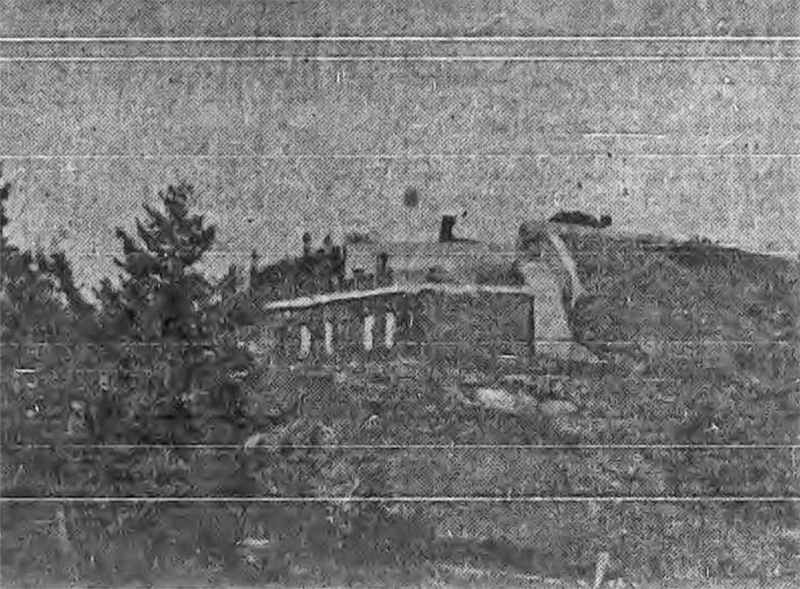 |
| Signal Hill From Esquimalt Road 1903 |
The 9.2 B.L. gun is one of great power and penetration. In the series of trials in England during which the photograph was taken, the projectiles fired were Palliser (solid) shot, weighing 282 pounds, with a charge of 270 pounds of powder. The gun was fired at various angles of elevation, the maximum range obtained being not less than 12 miles, and it was calculated that the extreme height attained by the projectile was about 16,000 feet, or three miles. This would bring Race Rocks light well within the range of the guns on Signal Hill. The time occupied by the flight of the shot was slightly over one minute. The result is one of the achievements of modern gunnery. Great range and penetration are largely due to the introduction of the wire-winding system, which gives high resistance to the guns, and thus enables heavier charges to be used. The coast 9.2 inch gun weighs 27 tons and has a muzzle energy of 19,200 foot-tons.
The 9.2 guns are not mounted in pits, as is the case of the other forts armed with 6.2 inch guns. The former are mounted on barbettes, having shields for the gun and crew, the whole being worked on a turntable. Solid platforms of brick and cement will be erected at the apex of Signal Hill and the two monsters will be mounted on these. The guns and mountings are not concealed, as is the case with the lighter guns. Over the tops of the guns, as protection from the weather, light corrugated iron hoods are erected.
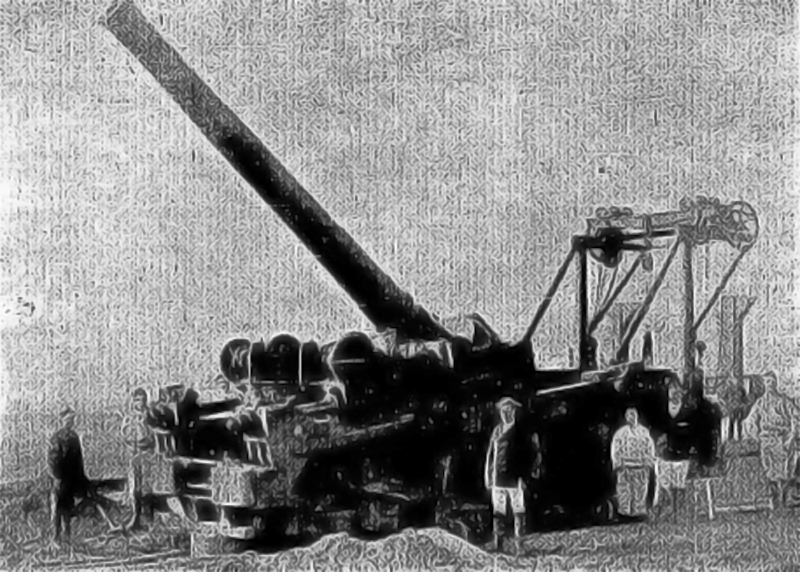 |
| The new 9.2 inch BL gun on Expanding Mounting |
COLONIST
November 1, 1903
The Old Barracks – Alterations and repairs to the old “C” Battery barracks at the east side of Beacon Hill Park, are now in progress, quite a staff of carpenters being on the work, which will take some time to complete.
December 27, 1903
The Changing Garrison, — There will be a change in the garrison at Work Point on Tuesday, No. 19 Company, 108 strong, in command of Colonel Gurdon, Capt. Wakefield and Lieut.’s White, Cameron and Wilson, will proceed from the barracks at Work Point at 8 a.m. on Tuesday and will embark at 8:30 at the ocean dock on board R.M.S. Empress of India, which has been fitted up to carry the soldiers to Hong Kong. The steerage quarters have been fitted with special accommodations for the troops. The garrison, which comes to replace the departing company, No. 58 from Halifax, is now on its way across Canada and is due to arrive at the Work Point barracks on Tuesday evening. Arrangements have been made for special cars to carry the departing garrison from Head street to the ocean dock and to take the newly arrived artillery men from bastion street on the arrival of the Charmer, to Head street.
Sailors Badly Hurt, — Two accidents took place on the Esquimalt road Christmas night in which the sailors were hurt. The first accident happened at about 10 o’clock in the evening, and the second half an hour later. The men were walking along the track when they were struck. One of the unfortunates had his foot badly crushed and was cut about the face. Last night both were reported as recovering.
School of Instruction — The results of the recent examinations show that 15 out of 16 members of the Fifth Regiment who attended the school of instruction classes were successful. Of these three qualified for company sergeant-major, obtaining over 80 percent., four for sergeant, securing over 70 per cent., four for corporal with over 60 per cent., and four for bombardier with over 45 per cent. This is very gratifying, and is a tribute to the ability of the students and the efficiency of the instructors. Those who have passed are to be especially congratulated. The examinations were stiff, and it required a thorough knowledge of all branches of military work to answer correctly the searching questions. Eighty-three was the highest percentage secured, which will give some idea of the character of the examinations.
Victoria Times
December 28, 1903
SOLDIERS WILL EMBARK TOMORROW
They Leave Here on China for Hong Kong
R.M.S. Empress of India, when she departs from here for the Orient tomorrow, will present the appearance of a troopship, and on her arrival at some of the Japanese ports may create a little excitement from the fact that the war feeling there prevailing is very intense, and any military movement is watched with peculiar interest. The ship has been fitted up ‘tween decks for the accommodation of company No. 83, R.G.A., which has been stationed at Work Point for some years, and which as previously reported, has been ordered transferred to Hong Kong. All told there are 125 men, members of the company, and six officers as follows: Major Gurdon, Capt. Wakefield, and Lieuts. Whyte, Cameron, Millman and Allen. The Empress, if proper connections can be made with the eastern express at Vancouver today, will be down here this evening, but, owing to a military regulation, no soldiers can embark until daylight, and so the ship will have to be held over until Tuesday.
December 30, 1903
THE ARTILLERYMEN FOR WORK POINT
Crossed the Continent in Seven Days —
Something About Experiment Tried in Transportation
Just seven days from Halifax to Victoria was the time taken by Company No. 58, R.G.A., in making its transcontinental tour. The company arrived on the Charmer last night, Major C.E. English in command, accompanied by Capt. M. Williams, Lieut. Geary and Lieut. Fall, all of the Royal Artillery, and Capt. Wright of the Army Service Corps. Of the rank and file there are 156 men of the Royal Garrison Artillery, 36 Royal Engineers, four of the Royal Army Medical Corps and one of the Army Ordnance Corps.
There are in all 224 in the company, which includes 25 Royal Engineers direct from England, 20 children and 12 women.
Regarding the trip overland Major English says: "We had a very good run through, and the C.P.R., which took charge of every detail of transportation, certainly handled it well. We encountered some very cold weather en route, and at Rat Portage and White River, along the north shore, the thermometer registered 35 degrees below zero. In one instance two cars were frozen up while a change of engines was being effected, but the inconvenience was only temporary, being soon remedied."
"The experiment in hammocks, is, I think, worthy of adoption. The men are not altogether in favor of this new method of transportation, but it is convenient, especially when sleeping cars are not available. More men can be carried, and the ventilation is better. The Imperial authorities fitted up one of the first class cars with hammocks. These were slung from beams in the cars, some longitudinally and others latitudinal. It was found that the former worked more successfully, as the latter swung together when the train was rounding curves. The former, too, allows of more men being accommodated in a car. The hammocks were used in a nature of an experiment to ascertain whether, in case of an emergency, box cars could be used for troops when passenger coaches could not be had, in case of declaration of war, and when it was found necessary to rush a large number of troops across the continent."
Local yachtsmen will be pleased to learn that Capt. Williams has brought his famous little yacht along, which has taken three firsts at Halifax this year. A number of horses and ponies and dogs also arrived with the company.
Football formed their chief active recreation on the journey, and several matches were played at various stopping points. The officers attributed the perfect health of the men to the exercise they were able to obtain in this way. Snowballing, of course, was indulged in at every available opportunity, and at Schreiber many of the men were slightly touched with frost, while two were severely frost bitten, while thus engaged.
The company were conveyed to Work Point in special cars last night, and were today busy settling down in their new quarters.
They were met at the C.P.R. wharf last night by the Fifth Regiment band, headed by which they marched up Bastion street and along Government to the corner of Yates, where cars were in waiting. A large number were on hand to witness the company’s arrival, and a great deal of interest was manifested in so fine a looking body of men.
According to a map of Work Point Barracks dated 1903, under the signature of Lt. Col. A. Grant, R.E., the barracks had been extended west to Smith St. and south to Fern St. This had taken over the original lots 1 - 5 in the process. Generally the Royal Engineers occupied the north end (West Bay), wood frame buildings constructed for "C" Battery, and the Royal Marine / Garrison Artillery the south end (Fern St.), in brick buildings built for them. Married quarters were in the north west corner of the barracks and the officer’s mess and quarters, behind the administration building, was on the Victoria harbor promontory. There was a hospital, isolation ward building, a mortuary, an underground magazine and gun shed near Rose Bay, the main entrance to the barracks remaining at the end of Head St.
Basically there are two precincts of heritage reference established and are based on the preceding descriptions. Currently extant are # 1075, # 1068, # 1070 and # 1071 as well as the magazine, # 1030, in the Royal Garrison Artillery precinct. In the West Bay or Royal Engineers precinct extant are # 1020 and # 1004, the Guardhouse formerly # 1001, has been sold to a private company and is now outside the perimeter fencing of the base, and the Officer’s Quarters and Mess building, # 1027, was "deconstructed" in 2006. Other buildings have suffered the same fate over the years, demolition by neglect in question, unseen by non caring eyes in Ottawa.
Colonist
December 30, 1903
ONE GARRISON GOES ONE COMES
No. 83 Company R. G. A. Embarked at Ocean Docks For Hong Kong
No. 58 Co. Will Arrive Tonight From Halifax By Steamer Charmer
Steamer Empress of India, which sailed from the ocean docks yesterday carried the officers and men and the wives and families of No. 83 Company Royal Garrison Artillery en route to Hong Kong, where they will take over the garrison work in that outpost of the Empire on their way about the chain of the Empire. Tonight, No. 58 Company, in command of Major English, who will shortly be promoted to the rank of Colonel, will arrive from Halifax by the steamer Charmer. The graft reached Vancouver yesterday. The men had crossed Canada from the fortress on the Atlantic coast using hammocks slung in the cars to test that manner of accommodation, instructions having been given to that effect by the War Department that they might determine the utility and comfort of such method of transportation in case of necessity.
The departing company, in command of Col. Gurdon, Capt. Wakefield and Lieuts. White, Milman, Cameron and Allen, formed on the parade ground at Work Point at eight o’clock yesterday morning and the roll call showed a full complement of six officers, 113 men and twelve women and children. They marched to the Esquimalt road where cars were waiting at the Head street switch to carry the artillerymen and their families to the ocean docks, where the white liner was in readiness for departure. Quite a number of spectators were on hand to witness the departure and bid farewell to the departing artillerymen who during their stay here made many friends. Sergt. Wood, who has done much for Association football during his stay here, as secretary of the league, will go on from Hong Kong to Woolwich, where he will take a course in gunnery.
The garrison which will arrive tonight from Halifax has had a very good record in shooting according to service papers. The force numbers in all 183 officers and men, a substantial increase in the number of the garrison. There are 144 of the Royal Artillery and forty Royal Engineers, as well as fifteen women and twenty-five children. The change of the garrison is being carried out after the manner inaugurated when the draft which has just departed came to Work Point. The garrisons are now being shifted step by step until the Empire’s outposts have been rounded and the artillerymen eventually, after doing garrison duty about the seven seas arrive in England again. The garrisons came to Halifax from the Bermuda’s and after serving at Halifax come to Esquimalt and thence to Hong Kong, and so, by steps, back to the home land.
WORK POINT BARRACKS
1903
Work Point Barracks Inside Main Gate
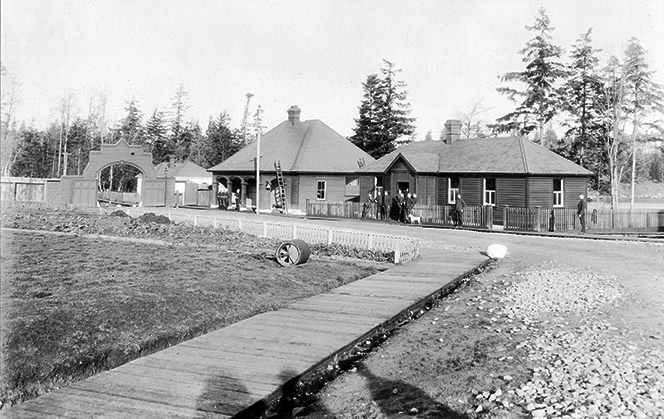 |
Work Point Barracks Inside Main Gate
Photo by W. Gourlie Blackie, Photographic Artist, Victoria West, B.C.
... run cursor over photo to zoom image ... |
... continued in 1904 ...
|

